 Author
Author |
Topic: Compass to make a Regular Pentagon/Heptagon (Read 9979 times) |
|
BMAD
Junior Member
 

Posts: 57
|
 |
Compass to make a Regular Pentagon/Heptagon
« on: May 23rd, 2014, 2:51pm » |
 Quote Quote  Modify Modify
|
Using only a compass to make circles of any size you choose, find a method to locate five points that if connected would make a regular pentagon.
Is it possible to make a heptagon using a compass and circles?
|
|
 IP Logged IP Logged |
|
|
|
dudiobugtron
Uberpuzzler
    

Posts: 735
|
 |
Re: Compass to make a Regular Pentagon/Heptagon
« Reply #1 on: May 23rd, 2014, 8:34pm » |
 Quote Quote  Modify Modify
|
So you can choose the radius of the circles exactly?
In that case, you can use maths to solve it pretty easily:
Construct a circle of radius r. Then, use the radius to find the side length s (eg by using the sin rule):
s = r * sin(72) / sin (54)
Then, choose any point on the circle you drew, set the compass to s, and mark out the 4 other vertices one at a time.
It's exactly the same for a heptagon, except of course you'd use different angles.
My guess is you aren't allowed to have an independent 'ruler' to measure your compass distance on, and so you could only set it to a 'unit' distance, or a distance you had already constructed.
|
|
 IP Logged IP Logged |
|
|
|
rloginunix
Uberpuzzler
    

Posts: 1029
|
 |
Re: Compass to make a Regular Pentagon/Heptagon
« Reply #2 on: May 23rd, 2014, 9:31pm » |
 Quote Quote  Modify Modify
|
These are known as Mohr-Mascheroni constructions. In the late 18-th century the Italian mathematician Mascheroni proved that anything that can be done with the ruler and compass can be done with the compass alone (restrictions apply). In the early 20-th century the Danish mathematician found, in the Copenhagen library, a book titled "The Danish Euclid" by Mr. Mohr published in the late 17-th century - roughly a century earlier the Mascheroni's work. So now these constructions are known as Mohr-Mascheroni. They could be quite laborious - bisecting a line segment takes 7 circles.
Before deep diving into this we should understand how and why the ruler and compass construction works. The shortest one I know is this:
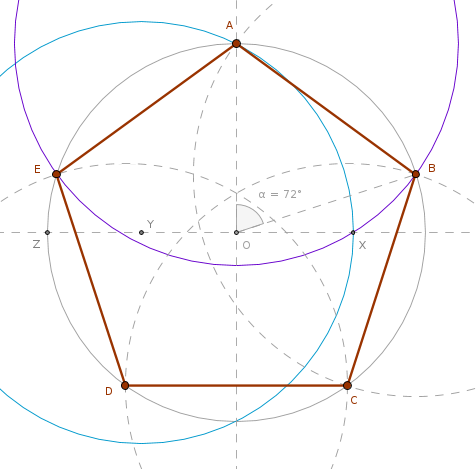
Construct an arbitrary circle and two perpendicular diameters, OA and OZ. Cut OZ in half at Y. Circle(Y, YA) intersects the line ZO at X. AX is the side of the regular pentagon. The proof is trigonometric (most equalities are from Pythagoras, trivial):
YC = sqrt(5)/2
OX = 1/2 + sqrt(5)/2 - 1 = (sqrt(5) - 1)/2
AX = sqrt(1 + OX^2) = 2*sqrt( (5 - sqrt(5))/8 ) = 2*sin36 = AB
Important deductions for a regular pentagon:
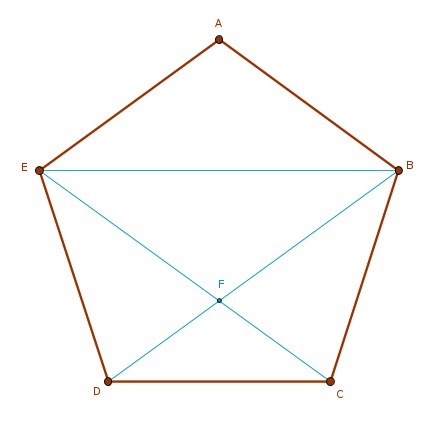
The triangle EAB is isosceles, hence the angle AEB = ABE = ( 180 - 108 )/2 = 36. We can apply this logic to all the remaining vertexes and diagonals and hence:
CBD = CDB = DCE = DEC = 36
But, for example,
ABC = 108 = ABE + x + CBD = 72 + x
x = 108 - 72 = 36 = DEB
and so on.
Hence, EBC = 72 and hence from the triangle CEB it follows that:
ECB = 180 - 36 - 72 = 72
which means that the triangle CEB is isosceles which means that the regular pentagon's diagonals are equal.
Take, for example, the triangle DEF. Let's prove that it's isosceles:
DFE = 180 - 36 - 72 = 72.
Hence ED = EF.
Since DBE = CEB = ECD = BDC and the angles at F are vertical then the triangles BFE and CFD are similar. Hence, if BE = x and FC = FD = x - 1:
x/1 = 1/(x - 1)
solving for x yields what's known as the golden ratio (1 + sqrt(5))/2 = the ratio of the diagonal of a regular pentagon to its side.
So I would think the first order of business for a compass-only construction is to figure out how to cut a line segment in a golden ratio using a compass alone.
|
|
 IP Logged IP Logged |
|
|
|
BMAD
Junior Member
 

Posts: 57
|
 |
Re: Compass to make a Regular Pentagon/Heptagon
« Reply #3 on: May 23rd, 2014, 9:57pm » |
 Quote Quote  Modify Modify
|
So are you saying a regular heptagon is possible?
I know i left "regular" out of the original posting but I did mean it to be there.
|
| « Last Edit: May 23rd, 2014, 9:58pm by BMAD » |
 IP Logged IP Logged |
|
|
|
rloginunix
Uberpuzzler
    

Posts: 1029
|
 |
Re: Compass to make a Regular Pentagon/Heptagon
« Reply #4 on: May 24th, 2014, 1:31pm » |
 Quote Quote  Modify Modify
|
If the meaning of the question is:
is the ruler and compass construction of a regular 7-gon possible
then the answer is of course no, it's impossible. Carl F. Gauss proved that the ruler and compass construction of a regular n-gon is possible iff n is a product of a power of 2 and some number of distinct Fermat primes. So, for example, the ruler and compass constructions of the regular 7, 9, 11, 13-gons is impossible.
On a separate note.
A. Adler (1863-1923) suggested using inversion as a generic way to solve the compass-only construction problems using the ruler and compass sequences (if they exist) as an input. It remains to be seen how it can be applied to this particular problem.
|
|
 IP Logged IP Logged |
|
|
|
BMAD
Junior Member
 

Posts: 57
|
 |
Re: Compass to make a Regular Pentagon/Heptagon
« Reply #5 on: May 24th, 2014, 9:55pm » |
 Quote Quote  Modify Modify
|
Brilliant
|
|
 IP Logged IP Logged |
|
|
|
rloginunix
Uberpuzzler
    

Posts: 1029
|
 |
Re: Compass to make a Regular Pentagon/Heptagon
« Reply #6 on: May 27th, 2014, 7:22pm » |
 Quote Quote  Modify Modify
|
It is really quite amazing what sqrt(15) - sqrt(3) can do for you.
|
|
 IP Logged IP Logged |
|
|
|
rloginunix
Uberpuzzler
    

Posts: 1029
|
 |
Re: Compass to make a Regular Pentagon/Heptagon
« Reply #7 on: May 30th, 2014, 4:08pm » |
 Quote Quote  Modify Modify
|
I've found 3 solutions so far: 24, 13 and 7 circles.
Notation. Circle(A, AB) = draw a circle with A as center and AB is radius.
Solution 1. Brute Force. 24 circles.
I obtained it via the Division approach:
divide the whole into solvable parts, obtain their solutions, find a way to combine the solution of the parts into a solution of the whole
The parts here are the atomic ruler and compass steps described above. So the objective then is to replace them with the compass-only equivalents which are well known. Experimenting with the construction I noticed that it is a bit more profitable to multiply than to divide so my algorithm is:
1). Double
2). Double
3). Double
4). Rotate
5). Bisect
Pick two arbitrary points A and B. Instead of cutting AB in half treat it as one quarter of the future diameter of the future base circle upon which the regular pentagon will be constructed - double AB at P1, double AP1 at AP2, double AP2 at AP3. P2 becomes the center of the base circle of radius P2P3. The traditional way to double the length of a line segment takes 4 circles, I optimized it to just 3 (see notes below).
Rotate the points A and P3 90 degrees about P2 along the circumference of the base circle to obtain the points P4 and P5. In the compass-only parlance it means constructing a square on a given circle with two points (A and P3) located already.
With P1 as center and P1P4 as radius draw a circle which will intersect the base circle at the points P4 and P5.
Bisect the P4P5 arc of the Circle(P1, P1P4) at P6.
The distance P4P6 is the side of a regular pentagon:
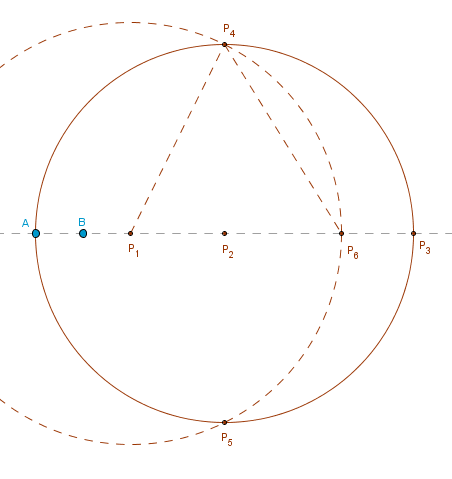
A bit more formally:
1). P1 : 2*AB = AP1, 3 circles (3 total).
2). P2 : 2*AP1 = AP2, 3 circles (6 total).
3). P3 : 2*AP2 = AP3, 3 circles. (9 total)
4). P4, P5 : P4, P2, P5 are collinear and P4P5 is perpendicular to AP3, 4 circles (13 total).
5). Circle(P1, P1P4) (14 total)
6). P6 on Circle(P1, P1P4) : arc P6P4 = arc P6P5, 5 circles (19 total).
5 extra circles are needed to construct the regular pentagon itself (by intersecting the circles of radius P4P6 with the base circle) making it a 24-circle construction.
All the compass-only constructions used here are well known and are covered in the textbooks on the subject. I'm not inventing anything new here. My only contribution is doubling the line segment optimization (which proved to be crucial for my second solution) and the overall approach. For documentation purposes and future reference I've collected them here (compass-only):
double the line segment, 4 circles
double the line segment, 3 circles
construct a square
bisect an arc
I went through the above exercise myself and the result is a mess. I don't think there's any value in posting that drawing. Let me know if you disagree.
|
|
 IP Logged IP Logged |
|
|
|
rloginunix
Uberpuzzler
    

Posts: 1029
|
 |
Re: Compass to make a Regular Pentagon/Heptagon
« Reply #8 on: May 30th, 2014, 5:41pm » |
 Quote Quote  Modify Modify
|
Solution 2. By Analogy. 13 circles.
Two aspects were crucial for finding this solution - my recollection of Euclid's B4.P10 and my 3-circle line segment doubling optimization.
In B4.P10 Euclid constructs a 36-72-72 triangle. The gist of this construction is to cut the given side of the future triangle at what Euclid calls "mean and extreme" ratio - golden ratio nowadays.
Once the division of the side in golden ratio is achieved finding the side of the regular pentagon is trivial - it takes just one more circle:
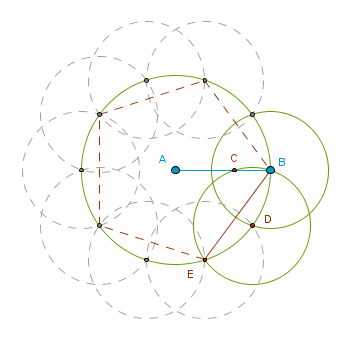
In the drawing above the large circle is centered at A with AB as its radius. All the smaller circles have AC is their radii where C cuts AB in golden ratio.
The Circle(A, AB) and the Circle(B, AC) are used to construct the Euclid's triangle. One more Circle(D, DB=AC) locates E and BE is the side of the regular pentagon sought after.
While proving that my 3-circle optimization works I decided to construct the circles with the points available to me. To keep the analogy with B4.P10 I named the interesting points A and B but we start the construction by picking two arbitrary points, D and E. Then - Circle(D, DE), Circle(E, ED), Circle(C, CA).
I then constructed the Circle(G, GH) and Circle(H, HG) which intersect at L. The ratio CA/CL is 1/1. Nothing interesting. I then constructed the circle(D, DH) and Circle(H, HD) which intersect at K and B:

Let's calculate the ratio CA/CB:
CA = sqrt(3)
CB = FB - FC = FB - sqrt(3)/2
FB = sqrt(DB^2 - DF^2) = sqrt(4 - 1/4) = sqrt(15)/2
CB = (sqrt(15) - sqrt(3))/2
CA/CB = 2*sqrt(3)/(sqrt(15) - sqrt(3))
To get rid of the radicals in the denominator multiply both sides of the fraction by sqrt(15) + sqrt(3):
CA/CB = 2*sqrt(3)*(sqrt(15) + sqrt(3))/(15 - 3)
CA/CB = 2*sqrt(3)*(sqrt(15) + sqrt(3))/12
CA/CB = sqrt(3)*(sqrt(15) + sqrt(3))/6
CA/CB = (sqrt(45) + 3))/6
CA/CB = (sqrt(9*5) + 3))/6
CA/CB = (3*sqrt(5) + 3))/6
CA/CB = 3*(sqrt(5) + 1))/6
CA/CB = (sqrt(5) + 1))/2
In other words the point C cuts AB in golden ratio (analogy with B4.P10). The cost is only 5 circles (we started with two arbitrary points D and E) and we are only 3 circles away form constructing the side MB of a regular pentagon with a compass only in 8 circles:
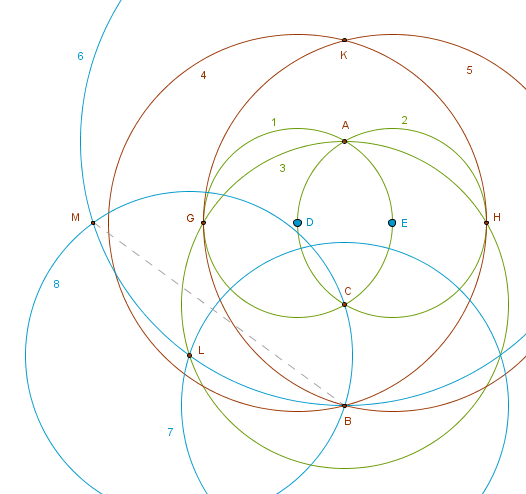
5 extra circles are needed to construct the regular pentagon itself (by drawing 5 consecutive circles of radius MB on the circumference of the base circle) making it a 13-circle construction:
Circle(D, DE)
Circle(E, ED)
Circle(C, CA)
Circle(G, GH)
Circle(H, HG)
Circle(A, AB)
Circle(B, AC)
Circle(L, LB)
MB = regular pentagon side ...
|
|
 IP Logged IP Logged |
|
|
|
rloginunix
Uberpuzzler
    

Posts: 1029
|
 |
Re: Compass to make a Regular Pentagon/Heptagon
« Reply #9 on: May 30th, 2014, 5:48pm » |
 Quote Quote  Modify Modify
|
Solution 3. Recursion. 7 circles.
This is a variation of the second solution and was nothing but automatic hunches and gut feelings. Again, we start with two arbitrary points D and E. Then - Circle(D, DE), Circle(E, ED), Circle(C, CA), Circle(G, GH), Circle(H, HG):

After using Euclid's division of the side in golden ratio once I decided to do it over and over - the pattern of the recurring golden ratio is omnipresent in a regular pentagon. The hunch was that B cuts LC in golden ratio - Circle(B, BC) intersects the base Circle(C, CA) at M and N where (hunch) MN is the side of the regular pentagon of which (hunch) 3 vertexes are now located - A, M, N.
We can now swing two circles with the radius MN centered at M and N which will locate the remaining two vertexes of the regular pentagon, P and Q. That will be an 8-circle construction. Is that number reducible?
If it exists the center of the 7-th circle to locate P and Q must be somewhere on the straight line passing through A and B. The number of candidate points is small. By symmetry A cuts KC in golden ratio - Circle(K, KC) intersects the base Circle(C, CA) at P and Q.
As I'm typing this I have no proof that this construction works (because my brain doesn't want to deal with me anymore) but I will supply it later:
Circle(D, DE)
Circle(E, ED)
Circle(C, CA)
Circle(G, GH)
Circle(H, HG)
Circle(B, BC)
Circle(K, KC)
|
|
 IP Logged IP Logged |
|
|
|
rloginunix
Uberpuzzler
    

Posts: 1029
|
 |
Re: Compass to make a Regular Pentagon/Heptagon
« Reply #10 on: Jun 1st, 2014, 6:52pm » |
 Quote Quote  Modify Modify
|
Solution 3 proof:
1). B cuts CL in golden ratio:
CL = CA = sqrt(3)
BC = (sqrt(15 - sqrt(3))/2
CL/BC = 2*sqrt(3)/sqrt(15) - sqrt(3)) = golden ratio (from Solution 2)
BL = CL - CB = sqrt(3) - (sqrt(15) - sqrt(3))/2 = (3*sqrt(3) - sqrt(15))/2
BC/BL = (sqrt(15) - sqrt(3))/(3*sqrt(3) - sqrt(15))
Multiply both sides of the fraction by 3*sqrt(3) + sqrt(15):
BC/BL = (3*sqrt(45) + 15 - 9 -sqrt(45))/(9*3 - 15) = (2*sqrt(45) + 6)/12 = (6*sqrt(5) + 6)/12 = (sqrt(5) + 1)/2 = golden ratio.
So: CL/BC = BC/CL.
Hence, the triangles LCN and LCM are isosceles Euclid's 36-72-72 triangles, hence the angle MCN is 72 degrees.
2). Since A cuts KC in golden ratio then the triangles CKQ and CKP are also isosceles Euclid's 36-72-72 triangles and hence the angles KCQ and KCP = 72 degrees. But, being radii, CA = CQ hence the triangles ACQ and ACP are isosceles, hence:
the angles CQA = CAQ = CAP = CPA = (180 - 72)/2 = 54 degrees. Hence the internal angle at the vertex A is 108 degrees.
And the rest of the proof is trivial: the triangles MCP and NSQ are congruent to the triangle MCN by SSS and hence the corresponding angles are equal ...
|
|
 IP Logged IP Logged |
|
|
|
BMAD
Junior Member
 

Posts: 57
|
 |
Re: Compass to make a Regular Pentagon/Heptagon
« Reply #11 on: Jun 4th, 2014, 4:49am » |
 Quote Quote  Modify Modify
|
Well done
|
|
 IP Logged IP Logged |
|
|
|
rloginunix
Uberpuzzler
    

Posts: 1029
|
 |
Re: Compass to make a Regular Pentagon/Heptagon
« Reply #12 on: Jun 6th, 2014, 9:16am » |
 Quote Quote  Modify Modify
|
Thank you.
Guys, sorry to interrupt your engaging discussions, but check this out!
Keeping the Reverse Order approach in mind I decided to invert the original problem:
given the five vertexes of a regular pentagon reconstruct the two vertexes of its generating line segment using a compass only.
In other words, given the points A, Q, N, M, P reconstruct the points D and E using only a compass. While searching for a proof for a solution that I've found I decided to (recursively) apply the 7-circle algorithm to the "bottom" points of the constructed regular pentagon - the points M and N. I've constructed a new regular pentagon RZUVW (see below) but then decided to connect the points U and N. Interestingly enough the straight line passed through the point E. And Line(V, M) passed through the point D. Both lines intersect at O. Then - Line(W, P) and Line(Z, Q) also intersect at O.
Hunch - DE is not some random line segment - it's the "bottom" of the smaller regular pentagon. Sure enough, after recursively applying my inverse solution (shown later) to DE I've constructed smaller and smaller regular pentagons which seem to form a sequence converging at the point O:
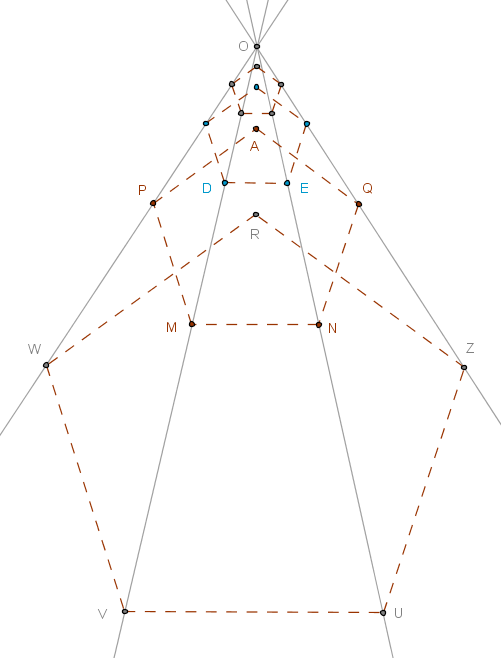
The angles are awkward: POQ = 66.37 degrees, MON = 25.74 degrees. I've picked them with a software tool (no calculations).
May be some interesting sequence or limit will come out of this.
Now the inverse solution. 4 circles are common, numbered 1, 2, 3, 4. To locate each vertex (D or E) 3 more circles are needed making it a 10-circle full solution. In the drawing below to avoid the clutter I only show the 7 circles needed to locate D:
Circle(P, PA)
Circle(Q, QA)
Circle(A, AS)
Circle(S, SA)
Circle(T, TS)
Circle(R, RV)
Circle(Z, ZA)
The intersection of the last two circles locates D:
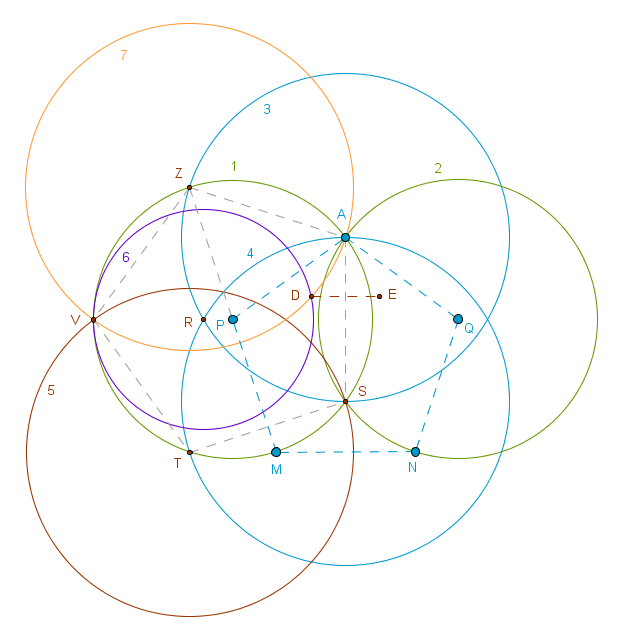
It's also interesting that the newly found vertexes S, T, V, Z form another regular pentagon tightly coupled with its parent - a side (PA) and a vertex (P) of the parent pentagon becomes the radius and the center of the circumcircle of its offspring. And it seems that there's yet another sequence going on here ...
|
|
 IP Logged IP Logged |
|
|
|
|
 WRITE MATH!
WRITE MATH!
 Home
Home  Help
Help  Search
Search  Members
Members  Login
Login  Register
Register WRITE MATH!
WRITE MATH!
 Home
Home  Help
Help  Search
Search  Members
Members  Login
Login  Register
Register